The Toshiba Q300 SSD Review: Toshiba Becomes a Retail Brand
by Billy Tallis on February 26, 2016 8:00 AM ESTRandom Read Performance
The random read test requests 4kB blocks and tests queue depths ranging from 1 to 32. The queue depth is doubled every three minutes, for a total test duration of 18 minutes. The test spans the entire drive, which is filled before the test starts. The primary score we report is an average of performances at queue depths 1, 2 and 4, as client usage typically consists mostly of low queue depth operations.

The Q300 performs only slightly worse than the Trion 100, but the difference is enough to push it below even the Crucial BX200 and into last place by a hair. The top-performing SATA drive by comparison, Samsung's 850 Pro, is twice as fast. The SanDisk Ultra II performs more like a MLC drive.
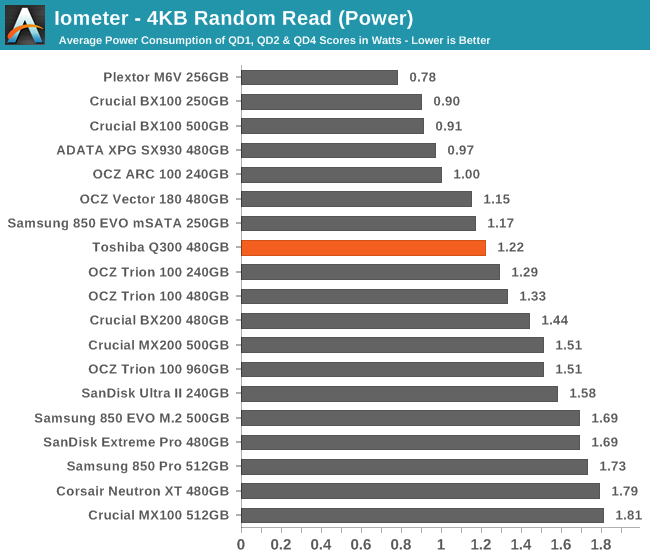
The Q300's power consumption isn't poor, but like most of the other TLC drives it's much less efficient than the typical MLC drive - let alone the SM2246EN-based BX100 and M6V.
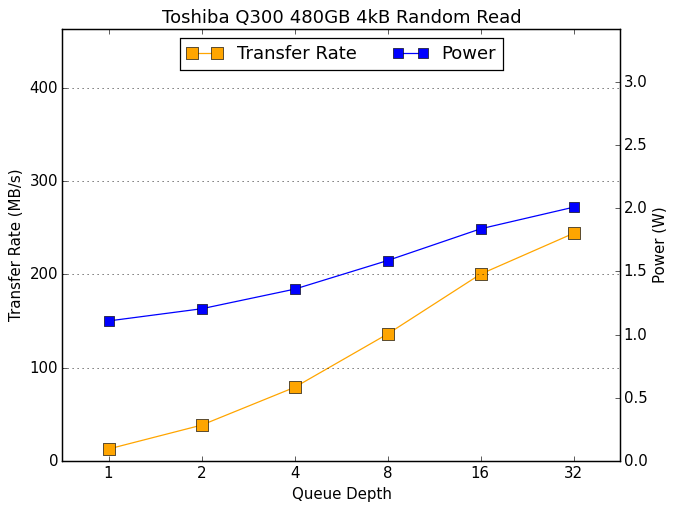 |
|||||||||
The Q300's random read performance scales with queue depth in a normal-looking manner, but the curve just isn't steep enough to compete.
Random Write Performance
The random write test writes 4kB blocks and tests queue depths ranging from 1 to 32. The queue depth is doubled every three minutes, for a total test duration of 18 minutes. The test is limited to a 16GB portion of the drive, and the drive is empty save for the 16GB test file. The primary score we report is an average of performances at queue depths 1, 2 and 4, as client usage typically consists mostly of low queue depth operations.
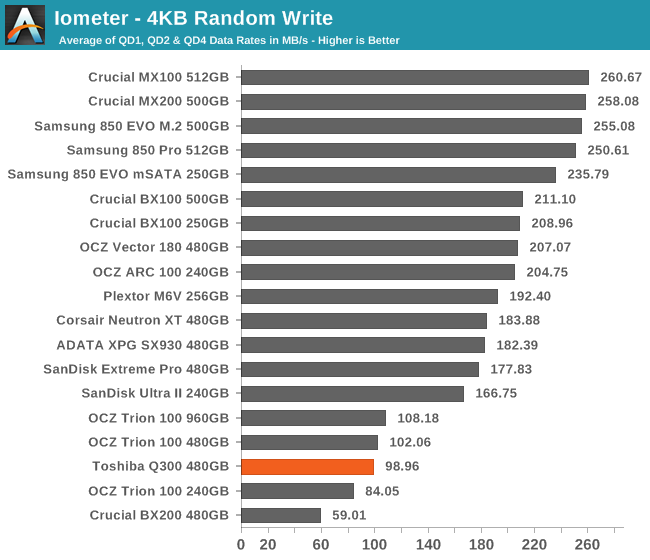
As with the random read test, the Q300, Trion 100, and BX200 are clustered at the bottom of the chart, demonstrating the they are not very good at mitigating the slower program times of TLC as compared to MLC flash. The SanDisk Ultra II seems to have much more effective SLC caching.
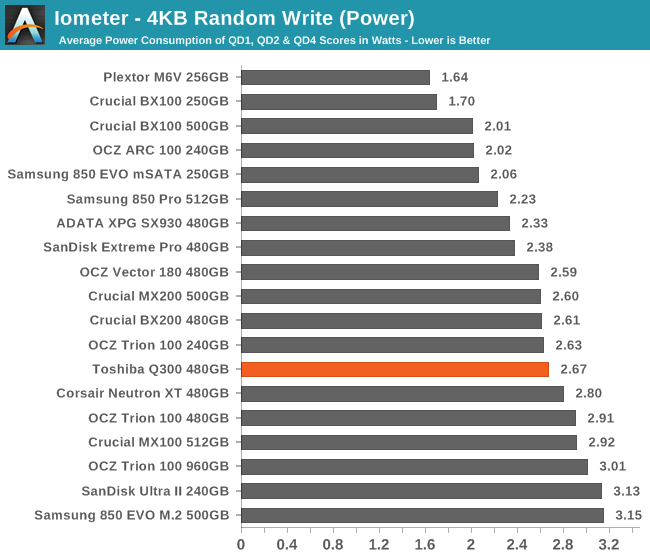
The Q300 was clearly a bit more efficient than the Trion 100 for random writes, but it doesn't put it anywhere near the efficiency of the drives that deliver solid performance.
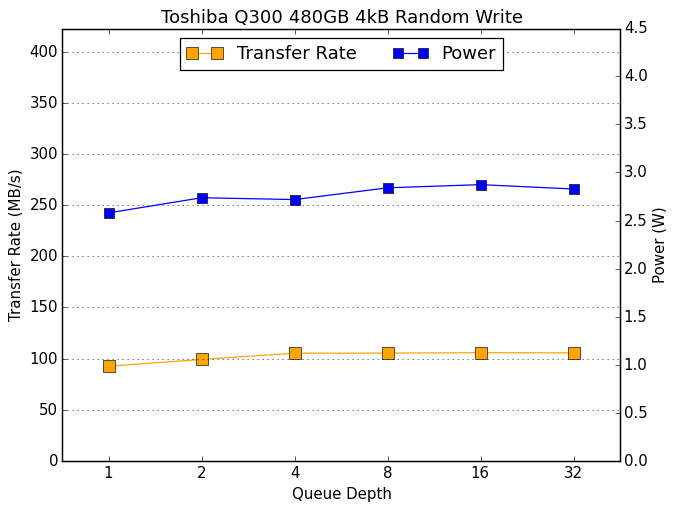 |
|||||||||
The Q300's random write performance scales very slightly as queue depth increases from one to four, and it stops there. The power consumption is lower than the Trion 100 at QD2 and higher. We've also seen this lack of scaling with the Crucial BX200, but the SanDisk Ultra II managed to use planar TLC flash without being similarly afflicted.










30 Comments
View All Comments
kmmatney - Friday, February 26, 2016 - link
I upgraded my laptop from a Samsung 830 to a SanDisk Ultra II 980GB (TLC + SLC cache) and the Ultra II is noticeably faster in everyday use. Anand reviewed it a while back and it was one of the lower powered drives as well - in fact more efficient than MX100 according to the review.Oyster - Friday, February 26, 2016 - link
I have a radical suggestion, guys. Can you please start review articles with the price comparison? This (price comparison) just seems out of place since the rest of the product attributes are already being compared to the competition on the first page. I often find myself jumping between the first and the last pages just to compare items. Plus there have been times when I have just skipped to the last page just for the price comparison... case in point, some of the ridiculously-priced mechanical keyboards - I know they're not even worth my time at $150.Also, when are you implementing single-page views??? :)
nathanddrews - Friday, February 26, 2016 - link
Hopefully never. If you want single-page, just click "Print This Article":http://www.anandtech.com/print/10084/the-toshiba-q...
aggressor - Friday, February 26, 2016 - link
Is this really considered their first retail drive? What about the Toshiba THNSNH model they released in 2013? I have one of them and it was retail boxed.jjj - Friday, February 26, 2016 - link
You should include PCIe drives in the results as prices are becoming more reasonable and the high end SATA models less appealing.ddriver - Friday, February 26, 2016 - link
Toshiba needs to reevaluate their pricing - 140$ for the 480GB model is far from a good deal considering that for 20$ extra you can get an evo which is significantly faster, has significantly longer warranty period and has 20GB extra capacity.mczak - Friday, February 26, 2016 - link
I wonder how the different Q300 differ and compare to each other?There's two series available: Q300 RG4 (models starting with HDTS7xxx) and Q300 RG5 (HDTS8xxx). The RG5 seems to be newer, I assume different flash (the tested one can be identified as a RG4 in the picture). But for all I know they could have completely different characteristics despite Toshiba wanting to believe you it's all the same...
mczak - Friday, February 26, 2016 - link
I suppose actually flash is going to be the difference - 15nm vs 19nm, so it would be like a Trion 150 (though the Trion 150 had 3 differences vs. the Trion 100, 15nm flash instead of 19nm, newer firmware (with larger SLC buffer), plus a thermal pad for the controller chip, the latter was likely the reason it had faster sustained write performance, and those other differences might not carry over to the Q300 - so there might not be much difference in the end after all).harrynsally - Friday, February 26, 2016 - link
?????? it appears that Toshiba's strategy may have been to use the Trion 100's earlier release to make sure everything was working properly before releasing the Q300 to catch the eye of a wider audience??????Just checked Newegg Trion 100 owner reviews.
44% rated the 120GB drive 1 star and 41% rated the 240GB drive 1 star.
Appears that OCZ SSDs still lack in quality, reliability and performance,
wagon153 - Friday, February 26, 2016 - link
You're taking Newegg reviews serious? Lol. The Kingston V300 has 4 stars and is as bad, if not worse then, old OCZ drives.